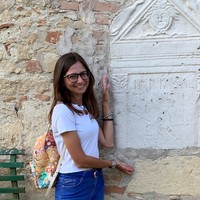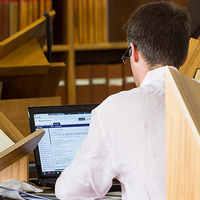Papers by Elisabetta Ugaglia
XIII Congreso Internacional sobre Cerámica Medieval y Moderna en el Mediterráneo (AIECM3), 2024
The archaeological excavation in Palazzo Mazzola in Asti, Italy, unveils a stratigraphic sequence... more The archaeological excavation in Palazzo Mazzola in Asti, Italy, unveils a stratigraphic sequence from Roman era to the early Middle Ages. A Roman domus, constructed around the 1st century AD near a cobbled street, undergoes structural changes during late antiquity. In the early Middle Ages, new buildings settle atop previous layers. The pottery, spanning from the Roman Empire to the post-medieval era, provides socioeconomic insights into Asti between the end of the Roman Empire and the establishment of the Lombard Duchy.
Il Platano, XLV, 2020
The paper resumes the research results of the MA Thesis "Early Medieval settlement in Asti. The a... more The paper resumes the research results of the MA Thesis "Early Medieval settlement in Asti. The archaeological excavation in Palazzo Mazzola" (University of Turin, Master's Degree in Archaeology and Ancient History), winner of the "Renato Bordone" Prize 2019.
Bizantini e Longobardi nelle aree emiliane. Culture e territori in una secolare tradizione, 2020
The research examines a group of six Early Medieval pottery vessels kept in the historical collec... more The research examines a group of six Early Medieval pottery vessels kept in the historical collections of the Civic Archaeological Museum at Asti. The analysis began with a preliminary examination of the pottery from the north-western part of the Italian peninsula during Late Antiquity, a period marked by a gradual impoverishment of local production and, simultaneously, a spread of glazed pottery (vasi listello and mortaria) and the partial survival of North African imports (terra sigillata, oil lamps).

NUME Gruppo di Ricerca sul Medioevo Latino, VI Ciclo di Studi Medievali (Firenze, 8-9 giugno 2020), 2020
The stratigraphic sequence discovered during the restoration works of the XVI century Palazzo Maz... more The stratigraphic sequence discovered during the restoration works of the XVI century Palazzo Mazzola, in Asti, revealed the frequentation of the area since the Roman Era (I-II century AD). In this period, a probable rich domus was built along a cobbled street, maybe one of the cardines minores of Hasta, the Roman municipium.
In Late Antiquity, structural modifications changed the domus, but the most relevant transformation happened during the Early Middle Ages.
A probable group of sunken-featured buildings established directly on the previous layers. These buildings have been recognised by some post-holes and a roughly rectangular pit-house with substantial post-holes, a fireplace with animal bones in the centre and a little furnace nearby.
The area once occupied by the Roman street started being used as a dump from which have come off most of the diagnostic materials.
Si pubblica un piccolo ma importante gruppo di vasi decorati provenienti da una sconosciuta necro... more Si pubblica un piccolo ma importante gruppo di vasi decorati provenienti da una sconosciuta necropoli di Asti inseriti in un quadro di recenti acquisizioni sulle fasi di età longobarda.
Conference Proceedings by Elisabetta Ugaglia
by NUME Gruppo di Ricerca sul Medioevo Latino, Massimiliano David, Stefano De Togni, francesca romana stasolla, Enrico Pomo, Eleonora Rossetti, Alessandro Melega, Alessandro Abrignani, Miriam Leonetti, Daniela Uva, Andrea Colagrande, Ambra D'Alessandro, Giulia Doronzo, Roberto Del Monte, Giovanni Carraretto, Antonio Macchione, Sarah Procopio, Gabriele Bonomelli, Idoia Areizaga Llorente, Giulia Calabrò, Nicola Martellozzo, Marcello Cabriolu, Elisabetta Ugaglia, Jacopo Russo, Elisa Pruno, Gabriele Castiglia, Marco Moderato, Eva Basile, Saverio Carillo, Zdzisław Koczarski, Gianluca De Simone, Angela Zaccara, Łukasz Halida, Luca Salvatelli, Felicia Tafuri, Valentina Milia, Nicoletta Usai, Silvia Summa, Eleonora Casarotti, Chiara Ribolla, Claudia Sojer, and Javier Castiñeiras López EBS Print, 2020
Conference Presentations by Elisabetta Ugaglia

XIIIth International Congress AIECM3 on Medieval and Modern Period Mediterranean Ceramics, 2021
The archaeological excavation in the XVI century Palazzo Mazzola, now location of Asti's Municipa... more The archaeological excavation in the XVI century Palazzo Mazzola, now location of Asti's Municipal Historical Archive, discovered a stratigraphic sequence from the Roman to the Early Medieval period. In this area was built a rich domus near a Roman cobbled street, around the I century AD, maybe one of the cardines minores of the ancient Hasta-Roman municipium founded around the second half of the II century BC. During the Late Antiquity, the Roman house seems to undergo a structural change, and twelve vertical clay pipes ('tubuli fittili') were put next to the street. In the Early Middle Ages, a probable group of sunken-featured buildings established directly on the previous layers. These buildings have been recognised by some postholes and a roughly rectangular pit-house with substantial postholes, a fireplace with animal bones in the centre and a little furnace nearby. The area once occupied by the Roman street started being used as a dump from which have come off most of the diagnostic materials. The pottery finds are datable from the Roman imperial age to the post-medieval era, even if there is a lack during the Late Middle Ages, probably because of the restoration of the palace between the XV and the XVI century, that could have removed the previous stratigraphy.
The analysis of late antique and early medieval artifacts allows to increase the archaeological information about Asti, especially from the socio-economic aspect, between the end of the Roman Empire and the establishment of the Langobard Duchy.
The presence of African red slip ware and other imported products could testify the economic and commercial vitality of the town in Late Antiquity, while the high number of early medieval coarse wares could show the change of the production in a more local way, as a consequence of a feeding transformation too. The morphological variety and the decorations on the surfaces of the raw ceramics could point out the presence of expert artisans or an aesthetic desire, beyond the functional role, of these artifacts.
There are also some fragments of late antique glazed mortaria (‘ceramica a vetrina pesante’) and the so called ‘catini-coperchio’; the latter are typical manufactures of the centuries between late antique and early medieval period in Piedmont and part of northern Italy.
Conference presentation for the VI Cycle in Medieval Studies held online by NUME Research Group o... more Conference presentation for the VI Cycle in Medieval Studies held online by NUME Research Group on the Latin Middle Ages.
The video is available at https://www.youtube.com/watch?v=R4zppD2rAiY&t=11s
Teaching Documents by Elisabetta Ugaglia
Presentation slides: lecture about the Archaeological Profession, held in the High School Liceo C... more Presentation slides: lecture about the Archaeological Profession, held in the High School Liceo Classico 'Vittorio Alfieri' (Asti).
Slides di supporto per il progetto 'Archeologia e storia di Asti medievale', presso il Liceo Clas... more Slides di supporto per il progetto 'Archeologia e storia di Asti medievale', presso il Liceo Classico 'Vittorio Alfieri' di Asti (prof. Roberto Gatti).
Presentation slides: lecture about 'Archaeology and history of medieval Asti', held in the high school Liceo Classico 'Vittorio Alfieri' (Asti), in collaboration with Philosophy and History teacher Roberto Gatti.
Thesis Chapters by Elisabetta Ugaglia
The thesis aims to analyse the stratigraphic sequence from the Roman to the Modern Era discovered... more The thesis aims to analyse the stratigraphic sequence from the Roman to the Modern Era discovered during the restoration works of the XVI century Palazzo Mazzola in Asti.
The Early Medieval settlement and pottery are especially investigated to update with new archaeological data the knowledge of the urban and socio-economic transformations of Asti between Late Antiquity and the Early Middle Ages.
The research analyses the so-called "Lombard pottery" finds in North-West Italy, then concentrate... more The research analyses the so-called "Lombard pottery" finds in North-West Italy, then concentrates on a group of six Early Medieval pottery flasks (Beutelflaschen) from the historical collections of the Civic Archaeological Museum in Asti.









Uploads
Papers by Elisabetta Ugaglia
In Late Antiquity, structural modifications changed the domus, but the most relevant transformation happened during the Early Middle Ages.
A probable group of sunken-featured buildings established directly on the previous layers. These buildings have been recognised by some post-holes and a roughly rectangular pit-house with substantial post-holes, a fireplace with animal bones in the centre and a little furnace nearby.
The area once occupied by the Roman street started being used as a dump from which have come off most of the diagnostic materials.
Conference Proceedings by Elisabetta Ugaglia
Conference Presentations by Elisabetta Ugaglia
The analysis of late antique and early medieval artifacts allows to increase the archaeological information about Asti, especially from the socio-economic aspect, between the end of the Roman Empire and the establishment of the Langobard Duchy.
The presence of African red slip ware and other imported products could testify the economic and commercial vitality of the town in Late Antiquity, while the high number of early medieval coarse wares could show the change of the production in a more local way, as a consequence of a feeding transformation too. The morphological variety and the decorations on the surfaces of the raw ceramics could point out the presence of expert artisans or an aesthetic desire, beyond the functional role, of these artifacts.
There are also some fragments of late antique glazed mortaria (‘ceramica a vetrina pesante’) and the so called ‘catini-coperchio’; the latter are typical manufactures of the centuries between late antique and early medieval period in Piedmont and part of northern Italy.
The video is available at https://www.youtube.com/watch?v=R4zppD2rAiY&t=11s
Teaching Documents by Elisabetta Ugaglia
Presentation slides: lecture about 'Archaeology and history of medieval Asti', held in the high school Liceo Classico 'Vittorio Alfieri' (Asti), in collaboration with Philosophy and History teacher Roberto Gatti.
Thesis Chapters by Elisabetta Ugaglia
The Early Medieval settlement and pottery are especially investigated to update with new archaeological data the knowledge of the urban and socio-economic transformations of Asti between Late Antiquity and the Early Middle Ages.
In Late Antiquity, structural modifications changed the domus, but the most relevant transformation happened during the Early Middle Ages.
A probable group of sunken-featured buildings established directly on the previous layers. These buildings have been recognised by some post-holes and a roughly rectangular pit-house with substantial post-holes, a fireplace with animal bones in the centre and a little furnace nearby.
The area once occupied by the Roman street started being used as a dump from which have come off most of the diagnostic materials.
The analysis of late antique and early medieval artifacts allows to increase the archaeological information about Asti, especially from the socio-economic aspect, between the end of the Roman Empire and the establishment of the Langobard Duchy.
The presence of African red slip ware and other imported products could testify the economic and commercial vitality of the town in Late Antiquity, while the high number of early medieval coarse wares could show the change of the production in a more local way, as a consequence of a feeding transformation too. The morphological variety and the decorations on the surfaces of the raw ceramics could point out the presence of expert artisans or an aesthetic desire, beyond the functional role, of these artifacts.
There are also some fragments of late antique glazed mortaria (‘ceramica a vetrina pesante’) and the so called ‘catini-coperchio’; the latter are typical manufactures of the centuries between late antique and early medieval period in Piedmont and part of northern Italy.
The video is available at https://www.youtube.com/watch?v=R4zppD2rAiY&t=11s
Presentation slides: lecture about 'Archaeology and history of medieval Asti', held in the high school Liceo Classico 'Vittorio Alfieri' (Asti), in collaboration with Philosophy and History teacher Roberto Gatti.
The Early Medieval settlement and pottery are especially investigated to update with new archaeological data the knowledge of the urban and socio-economic transformations of Asti between Late Antiquity and the Early Middle Ages.